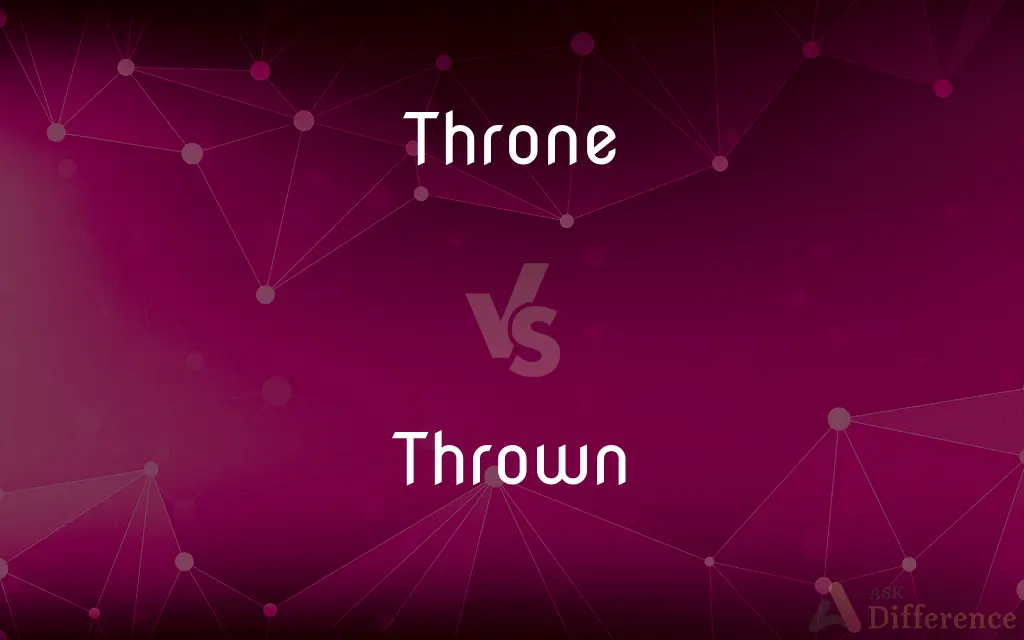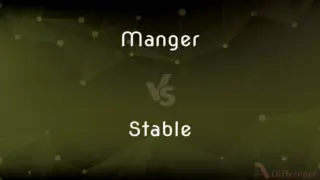Throne vs. Thrown — What's the Difference?
By Urooj Arif & Fiza Rafique — Updated on April 25, 2024
A throne is a ceremonial chair for royalty or bishops, symbolizing authority; thrown is the past participle of throw, indicating an object was propelled.

Difference Between Throne and Thrown
Table of Contents
ADVERTISEMENT
Key Differences
A throne is a formal seat used primarily by monarchs and high-ranking officials during ceremonies, symbolizing sovereignty and governance. Thrown, on the other hand, is the past tense and past participle form of the verb 'throw,' which refers to the act of propelling something with force through the air.
Thrones are often found in palaces and important religious sites and are richly decorated to signify status and power. Whereas, thrown is used to describe an action in various contexts, such as someone being thrown out of a place, or an object being thrown during sports or conflicts.
Historically, thrones have been a symbol of not just royal authority but also divine sanction in many cultures, often designed with elaborate ornamentation and positioned prominently within formal settings. In contrast, thrown is a verb form that appears in many idiomatic expressions, such as "thrown under the bus" or "thrown into confusion," emphasizing sudden or forceful action.
The concept of a throne is static, associated with stability, permanence, and tradition within a cultural or institutional hierarchy. Thrown, however, implies motion, change, and sometimes unpredictability, as it describes the result of an action that moves or displaces.
Thrones play a critical role in ceremonies and are often part of the heritage and iconography of a monarchy or church. Thrown, however, is a common verb in the English language, used in both literal and metaphorical senses to discuss the dynamics of various situations.
ADVERTISEMENT
Comparison Chart
Definition
A ceremonial chair for dignitaries.
Past participle of "throw."
Usage Context
Ceremonial, symbolic of authority.
Describes the action of propelling.
Physical/Metaphorical Role
Physical object and a symbol of status.
Primarily a verb indicating an action.
Cultural Significance
Significant in monarchy and religion.
Used widely in various expressions.
Example Setting
Palaces, formal events.
Sports, discussions, confrontations.
Compare with Definitions
Throne
A ceremonial seat for a sovereign or bishop.
The queen sat on the throne during the coronation.
Thrown
Used to describe sudden or forceful displacement.
He was thrown from his bike during the accident.
Throne
Associated with power and governance.
Ascending to the throne involves many responsibilities.
Thrown
Refers to launching with intensity.
They were thrown into the project with little preparation.
Throne
A symbol of royal or ecclesiastical authority.
The throne has been an emblem of monarchy for centuries.
Thrown
Past participle of throw, to propel something through the air.
The ball was thrown with great force.
Throne
Part of a kingdom's or church's regalia.
The throne room was prepared for the official ceremony.
Thrown
Appears in phrases indicating betrayal or trouble.
She felt thrown under the bus by her colleagues.
Throne
A seat used during state or church ceremonies.
The bishop approached the throne to give his blessing.
Thrown
Involved in expressions of creating disorder.
His remark thrown the meeting into chaos.
Throne
A throne is the seat of state of a potentate or dignitary, especially the seat occupied by a sovereign on state occasions; or the seat occupied by a pope or bishop on ceremonial occasions. "Throne" in an abstract sense can also refer to the monarchy or the Crown itself, an instance of metonymy, and is also used in many expressions such as "the power behind the throne".
Thrown
Past participle of throw.
Throne
A ceremonial chair for a sovereign, bishop, or similar figure
King Solomon's great ivory throne
The throne room
Thrown
Past participle of throw
Throne
Place (someone) on a throne
The king was throned on a rock
Thrown
Launched by throwing.
A thrown weapon
Throne
A chair occupied, as by a monarch or prelate, as a mark of rank or distinction on state or ceremonial occasions, often situated on a dais and sometimes having a canopy and ornate decoration.
Thrown
Twisted into a single thread, as silk or yarn.
Throne
One who occupies a throne.
Thrown
(slang) Confused; perplexed.
I was totally thrown by his bizarre remarks.
Throne
The power, dignity, or rank of one who occupies a throne.
Thrown
Caused to fall to the ground;
The thrown rider got back on his horse
A thrown wrestler
A ball player thrown for a loss
Throne
Thrones(Christianity) The third of the nine orders of angels in medieval angelology.
Thrown
Twisted together; as of filaments spun into a thread;
Thrown silk is raw silk that has been twisted and doubled into yarn
Throne
To install in or occupy a throne.
Throne
An impressive seat used by a monarch, often on a raised dais in a throne room and reserved for formal occasions.
He approached the throne reverently.
Queen Victoria sat upon the throne of England for 63 years.
The prince's newborn baby is fifth in line to the throne.
Throne
Leadership, particularly the position of a monarch.
Throne
The seat of a bishop in the cathedral-church of his diocese; also, the seat of a pope.
Throne
Other seats, particularly:
Throne
A seat used for urination or defecation, such as a chamber pot, toilet, or the seat of an outhouse.
Throne
(music) A kind of stool used by drummers.
Throne
(Christianity) A member of an order of angels ranked above dominions and below cherubim.
Throne
To place on a royal seat; to enthrone.
Throne
To place in an elevated position; to give sovereignty or dominion to; to exalt.
Throne
To be in, or sit upon, a throne; to be placed as if upon a throne.
Throne
A chair of state, commonly a royal seat, but sometimes the seat of a prince, bishop, or other high dignitary.
The noble king is set up in his throne.
High on a throne of royal state.
Throne
Hence, sovereign power and dignity; also, the one who occupies a throne, or is invested with sovereign authority; an exalted or dignified personage.
Only in the throne will I be greater than thou.
To mold a mighty state's decrees,And shape the whisper of the throne.
Throne
A high order of angels in the celestial hierarchy; - a meaning given by the schoolmen.
Great Sire! whom thrones celestial ceaseless sing.
Throne
To place on a royal seat; to enthrone.
Throne
To place in an elevated position; to give sovereignty or dominion to; to exalt.
True image of the Father, whether thronedIn the bosom of bliss, and light of light.
Throne
To be in, or sit upon, a throne; to be placed as if upon a throne.
Throne
The chair of state of a monarch, bishop, etc.;
The king sat on his throne
Throne
A plumbing fixture for defecation and urination
Throne
The position and power of one who occupies a throne
Throne
Sit on the throne as a ruler
Throne
Put a monarch on the throne;
The Queen was enthroned more than 50 years ago
Common Curiosities
What is the historical significance of thrones?
Thrones have historical significance as symbols of divine right and political power in various cultures.
Can thrown be used metaphorically?
Yes, thrown is often used metaphorically in phrases like "thrown under the bus," which means to be betrayed or unfairly blamed.
What does it mean to be thrown out?
Being thrown out means to be forcibly removed from a place or situation.
What is the purpose of a throne?
A throne is used as a ceremonial seat for a monarch or bishop, symbolizing authority and governance.
Where can thrones typically be found?
Thrones are typically found in palaces, castles, and significant religious buildings.
How does a throne contribute to the decor of a setting?
A throne often serves as a central piece in the decor of royal or ceremonial settings, adding grandeur and a visual representation of authority.
What materials are typically used to make thrones?
Thrones are typically made from luxurious materials like gold, velvet, and fine woods, adorned with jewels and intricate carvings to reflect the prestige of the occupant.
How does the meaning of "thrown" change in different contexts?
The meaning of "thrown" can vary widely, from physically tossing something to metaphorically being put into a challenging situation, depending on the context in which it is used.
Are there cultural variations in the designs of thrones?
Yes, the design of thrones varies significantly across different cultures, reflecting unique artistic styles, cultural values, and historical influences.
In what kinds of sports or activities is the term "thrown" frequently used?
The term "thrown" is frequently used in sports such as baseball, football, and javelin throw, where propelling objects through the air is a fundamental part of the activity.
Share Your Discovery

Previous Comparison
Platypus vs. Puggle
Next Comparison
Manger vs. StableAuthor Spotlight
Written by
Urooj ArifUrooj is a skilled content writer at Ask Difference, known for her exceptional ability to simplify complex topics into engaging and informative content. With a passion for research and a flair for clear, concise writing, she consistently delivers articles that resonate with our diverse audience.
Co-written by
Fiza RafiqueFiza Rafique is a skilled content writer at AskDifference.com, where she meticulously refines and enhances written pieces. Drawing from her vast editorial expertise, Fiza ensures clarity, accuracy, and precision in every article. Passionate about language, she continually seeks to elevate the quality of content for readers worldwide.














































